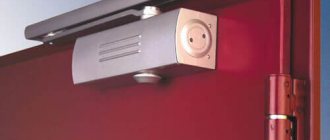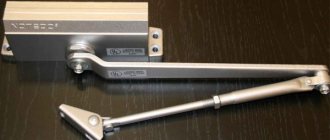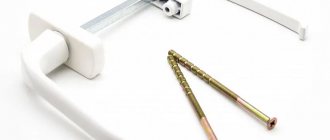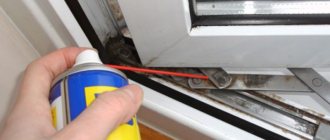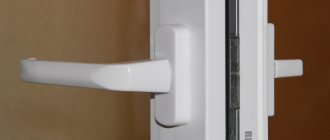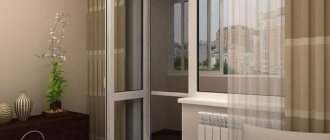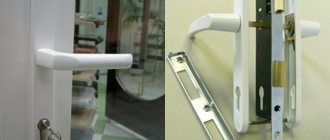Plastic doors are in great demand due to their not too high cost. They are durable and comfortable, very practical. They are used for installation at the entrance to a room or inside it. To make using the product even more convenient, you should install a door closer on a plastic door. This practical device minimizes heat loss and prevents damage to finishing materials. Next, we will consider what a door closer is for a plastic door, types of devices and installation rules.
Features of plastic doors and scope of application
Plastic systems have many advantages compared to wooden and metal structures:
- light weight, which allows you to install the door even with not very strong walls;
- ease of installation, transportation, replacement;
- the ability to make glass inserts to increase visibility and lighting in the room;
- resistance to moisture, detergents, aggressive environments, hence ease of care and cleaning.
All these characteristics make plastic structures popular. Such doors are installed in residential premises, but they are even more in demand in non-residential buildings. Plastic systems are used at the entrance to shopping centers and supermarkets, they are used in pharmacies, hospitals and any medical institutions. They are in demand in production, laboratories, and offices.
Plastic doors are primarily in demand where significant flows of people constantly move. Since the most common design is the swing type, with frequent use the canvas can quickly become unusable due to clapping.
To make the door last longer and make it comfortable to use, a door closer will come in handy.
How to adjust the door closer yourself
If for some reason it is not possible to invite a professional to set up the mechanism, you can try to carry out the process yourself. Adjusting the product requires knowledge and patience. Step-by-step instructions will help you set up the equipment and save you time. To work, you will need a wrench, a hexagon, and a screwdriver. Adjustment is carried out using hydraulic valves, turning which by just five degrees significantly changes the closing speed.
Do not completely unscrew the screws as you will damage the mechanism and void the warranty. In addition, lubricating oil will leak out.
- If you can't see the adjustment screws, they're probably under the cover. In the budget version, the casing is made of plastic, while the best manufacturers use metal for a high-quality finish.
- If you find oil under the cap, the best advice would be to purchase a new product, since it is hopelessly broken. If there is no leakage, you can continue with the setup.
- If there is no adjustment diagram, you will have to experiment a little to understand which screw is responsible for what.
- The adjustment should not be more than 1/8 of the stroke. Turn the screw clockwise to slow down and counterclockwise to speed up, then observe the effect.
- Open the door several times and watch it close. If the mechanism works correctly, you're done. If not, make another adjustment.
Why is a closer needed?
A door closer for plastic doors is comfort for people and the durability of the entrance system, its protection. The main purpose of this fitting is that it closes the sash itself, and does so slowly and smoothly, without jerking or unnecessary noise.
Why a closer is useful:
- He closes the door. A person does not need to monitor this himself; all the work is done by the mechanism. With it you don’t have to worry that the sash will remain open.
- Minimizes noise during operation. A plastic door does not slam as loudly as a metal one, but if this happens constantly, then there will be significant noise in the store or office. Also, sounds from a frequently closing door will not disturb people in neighboring rooms.
- Protects walls and finishing materials. This is again due to the slamming of the sash, which often causes the plaster to fall off in the places where the frame is mounted. And the door covering itself and its elements will suffer less from the load.
- Guarantees long-term operation of all accessories. Any jerks, sudden closing of the sash due to a draft - all this creates additional stress on the lock and handle. If they close smoothly, they will work much longer and their fastening will not become loose.
- Saves heat. This is very important for entrance doors: by closing them behind each person, heat loss is minimized.
The door closer performs many useful functions, so when installing a plastic door, you should also take care of its installation. It is an important element for those premises where access to people should be limited.
Application area
The door closer is an adjustable, spring-loaded mechanical lever filled with hydraulic fluid that is used to smoothly close the door after it has been opened. It dampens pops and increases safety:
- Doors must always be completely closed. If the equipment is missing or does not work well, then the protection is compromised. Deadbolt failure can be caused by defects in the box or a malfunction of the mechanism.
- The product regulates the force and speed of movement, preventing injuries to small children and people with disabilities.
- Most mechanisms are sold with a function to open smoothly, slowing down or even stopping the door at some point. This will protect adjacent walls and other property from impacts.
- The product increases the level of property security. Because it securely locks the lock after someone walks through the door. You won't have to worry about the premises being left open to thieves or unauthorized persons.
Different types of door closers
Although they all perform a similar function, there are different types of mechanisms that influence choice. The popularity of the model depends on the average price range, as well as on your needs.
There are products that are better suited for wooden doors, automatic or electromagnetic. Proper sizing also affects operational efficiency. If you choose equipment with unsuitable characteristics, it will be difficult to use it.
Closers are:
- overhead, double-sided;
- hidden, framed inside;
- floor-mounted, with fixed open position;
- two and single speed.
Design varieties
You can buy door closers for plastic doors with a lever or sliding rod. The first option is more common because it is easier to operate. This closer is reliable and not too expensive. You can install it yourself.
A device with a sliding rod is used less frequently. Although such fittings are considered more modern, they have a big disadvantage: the mechanism does not work well during sudden temperature fluctuations or in the cold. Therefore, it is better to install it for interior structures.
Depending on the design of the devices, they are also divided into two categories:
- With a gear. It has a toothed rack and a lever transmission. The operation of the device is impossible without lubrication, and it will react strongly to temperature. In severe frosts, the closer will not work well. It has no other disadvantages: it guarantees a smooth rebate and good pressing of the sash to the frame.
- With a fist. This design is more often used in floor closers. The fittings can be mortise or overhead. The working elements of the device are a spring, a screw to adjust it, as well as a piston and shaft.
Some tips for using the door closer
To extend the life of the closer, you must follow some rules for its operation. First of all, you cannot “help” the canvas open faster and put objects under it. It is not yet allowed to hang on the door or door closer rods. Young family members need to be warned about this, as they love to play while hanging on the door structure.
If simple rules are not followed, the seals in the closer will begin to deteriorate and the piston will wear out. Restoring such mechanisms will require some effort.
What to look for when purchasing
The price of door closers for plastic doors varies greatly. What does this depend on? From a set of characteristics that you should pay attention to when purchasing.
The most important of them:
- Installation location and dimensions. They are selected depending on the size of the sash itself and the purpose of the room.
- Door weight. Geometric dimensions, the presence of glass inserts, the number of double-glazed windows - all this determines the weight of the structure. There are 7 categories of closers. Products of 750 mm are designed to ensure the functionality of a door weighing 20 kg. The largest ones - 1600 mm will work on a door weighing 160 kg. For plastic systems, there is no point in overpaying and purchasing “heavyweights”. Otherwise, you will have to forcefully open the door.
- Operating temperature range. For the entrance group, this is an important indicator; here it is necessary to focus on the climate zone. There are special frost-resistant models; they use a special lubricant that does not become too viscous in the cold.
- Adjustment options. The closer assumes the ability to change the speed of closing the doors.
- Additional functions. Some models have a so-called stop function. This allows you to fix the blade in the open position, and at different opening angles. This is convenient when you need to carry any cargo, furniture or a stroller.
- Brand and warranty. If a manufacturer produces high-quality products, has been on the market for more than one year and issues a warranty card, then such a product cannot be cheap.
When purchasing a door closer for a plastic door, you should consider who will install it. The product kit must include instructions describing the entire installation process, as well as the adjustment of both screws of the device.
What do you need to know about the device?
The door closer device is simple. It does not have a large number of complex mechanisms, and its action is based on the accumulation of energy when opening the door and spending it on pressing the leaf to the frame. Most often this is achieved using a spring, less often a hydraulic circuit is used. In this case, the mechanism has a rack and pinion design, greater clamping force and is more expensive. The operating principle of a door closer with a hydraulic circuit is as follows:
- The lever has a special gear located on its axis; when the door opens, it rotates and the piston part of the structure compresses the spring.
- When the impact on the door stops, the spring begins to gradually return to its original state, pushes the piston, the gear rotates, and the lever mechanism smoothly closes the door.
Which closer to choose for a plastic door
In order for the device to operate smoothly, it is equipped with cavities and channels that are filled with oil. Smoothness depends on the internal clearance of the channels, which can be adjusted.
Which closer to choose for a plastic door
The choice of a door closer depends not only on what kind of mechanism you want and how much you are expecting, but also on the weight and design of the system itself. Heavy and massive doors require reliable closers capable of moving a large mass; for light interior doors, you can get by with a simple spring mechanism.
Installation location
You can install the door closer on a metal-plastic door anywhere. This depends on the design parameters.
Devices are:
- Lower ones. Such a mechanism must be provided simultaneously with the installation of the door, since it is almost impossible to install it later. The installation process itself is quite complicated and not very convenient. Because of this, bottom closers are not used very often.
- Upper. The most popular type of closers. It is easy to install and fits in the top corner of the sash. It will not interfere with the free movement of people or objects through the doorway.
- Hidden or framed. It is unlikely that you will be able to install such a device on your own. Often the door closer is sold together with the door; it is fixed on the frame.
If you need to simply and quickly install a door closer on a plastic structure, then the best choice would be the top option. It will require a minimum number of fasteners.
Installing and adjusting a door closer: basic rules and installation steps
Springs, rubber bands, counterweights and other devices traditionally used to ensure “automatic” closing of doors are a thing of the past. Now there are inexpensive mechanisms on sale that collectively solve all these problems. If you know how to properly install a door closer, you won’t have to pay for someone else’s services. Moreover, the method of attaching and adjusting it is simple.
Comparison table of characteristics
The summary table contains the main parameters of the considered models.
| Model | Dimensions (cm) | Weight, kg) | Sash width up to (cm) | Price, rub.) |
| Maxbar TS 2000 VBC EN2/4/5 | 22.6x6x4.8 | 2,14 | 125 | from 3860 to 4000 |
| DORMA TS-90 IMPULSE EN3/4 | 5.6x24.6x46 | 1,7 | 110 | from 10310 to 11200 |
| APECS DC-26/100-120-F2-MS | 13x31x8 | 3,25 | 140 | from 3729 to 4100 |
| HAG-603 | 23x30x56 | 1,5 | 60 | from 8890 to 9500 |
| Geze TS 500 NV EN1-4 | 27.8x8.2x4.2 | 4,5 | 110 | from 9527 to 10500 |
Additional features of work
Conventional automatic closing is not always convenient, so door closers for different entrance doors are equipped with additional devices that provide:
- Soft closing. The closing speed of the door varies depending on its position. At the initial stage the speed is maximum, and at the very end it slows down. There is no impact on the jamb.
- After-clap option. It also consists of a two-stage movement of the door leaf. At the final stage, the movement accelerates. The final closure takes place with effort. Designed for door structures equipped with latches.
- Delay function. The return movement does not begin immediately, but after a half-minute delay.
- Fixing an open door. When swinging to a large angle, automatic closing is blocked. The doorway remains open. The mechanism is turned on again by manual force.
Upper
Another name is hinged or overhead. Installed on the top of the door frame. One part of the structure is attached to the frame, the other part is attached to the door leaf.
There are varieties in this class that differ in the method of transmitting force:
- Lever mechanism. The force of the compressed spring is transmitted to a system of two iron levers. This design is reliable. It has two drawbacks: it looks unattractive when closed due to protruding levers; the entire structure is not resistant to intentional breakdown.
- Parallel traction. The device is similar to the lever type, but the lever layout contains an additional bracket. In the closed position, the levers are parallel to the door leaf. The result is a design that is hardly noticeable.
- Sliding channel. The force is transmitted to a sliding rod, one end of which is rigidly fixed, and the other moves in a closed channel. This option has no protruding parts, which makes it unnoticeable and resistant to damage.
Floor-standing
They are attached to the floor and partially recessed into it. There are options that differ little from the upper models, only fixed at the bottom. But the most widespread are leverless designs with a lower loop attached to the axis of the closer. Floor-type mechanisms are usually installed for glass sashes that open in both directions. In rooms with increased aesthetic requirements, the floor option is indispensable.
Hidden
These are lever-type mechanisms with a body completely recessed inside the door leaf. Only the lever attached to the frame protrudes outward. Doors with a thickness of at least the size of the body being installed and having a cavity inside are suitable for their installation. They are low-power, therefore they are not able to cover heavy structures.
The procedure for adjusting the closer mechanism
There are two “adjusting” screws for this purpose. Each of them sets the speed of the web in a certain mode. To understand the principle of regulation, you need to understand the following:
- the closer serves only to close the door;
- this is done in 2 stages. On the first, the blade moves at an increased speed; on the second, it is significantly reduced to eliminate a sharp knock when the sash touches the jamb.
Screw 1 – sets the speed in the range from an angle of 180º (the blade is fully open) to 150.
Screw 2 – regulates the movement of the leaf on the last segment of the path from 15 to 0 (its fine-tuning, that is, until the leaf is completely adjacent to the door block).
- If you completely unscrew any of the screws, oil will begin to flow from the closer housing. Therefore, in the process of setting up the device, it is not recommended to make more than one rotation of the screw around the axis. The mechanism is initially configured to operate according to average parameters, and during adjustment it is only necessary to make small adjustments to the position of the screws. As a rule, they rotate no more than ¾ in any direction.
- Sometimes by adjusting the second screw it is not possible to achieve a soft fit of the sash. A lever with a thread on the rod will help here. By screwing/unscrewing the “arm”, it is easy to determine its optimal position, at which all that remains is to slightly tighten the adjusting screw.
Installing a door closer is not only about ease of use. Smooth, accurate closing significantly reduces the load on the hinges, thereby preventing increased wear and distortion of the blade. It is advisable to install such a device not only at the entrance to the home, but also in ancillary buildings on the site, as well as in the house if the interior door is quite massive. Well, the reader already knows how to install and adjust the mechanism.
Related article: The door lock is jammed, what to do?
Advantages and operating principle
The main advantages of this device:
- Protects the user from noise coming from the street;
- Provides high-quality thermal insulation, as there are no drafts;
- Easy and safe operation;
- Beautiful appearance.
The device is made of a lever rod and a housing with mechanical elements that promote a tight fit of the doors. The device is based on a powerful spring; it is activated by a piston. The mechanism is installed in a capsule that is filled with a lubricating fluid, so after compression the door smoothly and silently returns to its original position. Adjustment occurs using special screws that are mounted on the side of the case. The rotation speed of these elements affects the time it takes for the door to close.
Some models are equipped with special valves that keep the door structure closed at 80 degrees. This is how the canvas smoothly returns to its original position with a slam at the last 14 degrees, this allows you to overcome the force of the latches and seals.
